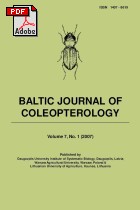Successional patterns of carabid fauna (Coleoptera: Carabidae) in planted and natural regenerated pine forests growing on old arable land
Main Article Content
Keywords
:
Carabidae, pine forest, plantation, natural regeneration, succession
Abstract
Pine forests of different age growing on old arable land were studied over the period of two years (2004/2005) with the aim to compare planted stands and stands derived from natural regeneration. Each three stands of the two forest types were subjected to elaboration of the fauna of Carabidae using pitfall traps. In four of the stands three traps were installed and in two of the stands nine traps were installed. Therefore, in total 30 traps were used. The sampling time covered middle of May to middle of September. Data were analysed with respect to number of individuals, number of species, and Mean Individual Biomass (MIB) of Carabidae as indicator of the stage of succession. Principal Components Analysis (PCA) was carried out to display characteristic patterns in the dataset.<br />In 2004 1615 individuals from 49 species and in 2005 1333 individuals from 51 species were collected. Altogether, 2948 individuals from 60 species were sampled. The most dominant species in both years of study was Pterostichus niger. Pterostichus oblongopunctatus, Poecilus versicolor, and Carabus hortensis showed high numbers of individuals in both years, too. In general, the study areas show variability with respect to numbers of species, individuals and MIB values between the respective sampling sites. The natural regenerated forests exhibit a significant decrease in numbers of species and a significant increase of MIB values with increasing age of the stand. The PCA done with the dataset shows a separation of the sampling sites with respect to stage of succession as main factor. However, there is also a separation of the natural stands from the planted forests.<br />The results provide with some insight into the succession of planted pine forests and natural regenerated pine forests on old arable land. The results of the study indicate that the origin of the stand (i.e. plantation or natural regeneration) indeed seems to be an important aspect concerning the formation of carabid coenoses during the process of succession. Particularly in the beginning, succession runs faster on the planted pine forests. The Carabid coenoses seem to be similar at early stages but differentiate in the run of the succession. However, besides the origin of the stands other factors, as soil factors, should be considered concerning the formation of carabid coenoses, too.
Article Details
Statistics
Downloads
Download data is not yet available.
Recommend Articles
